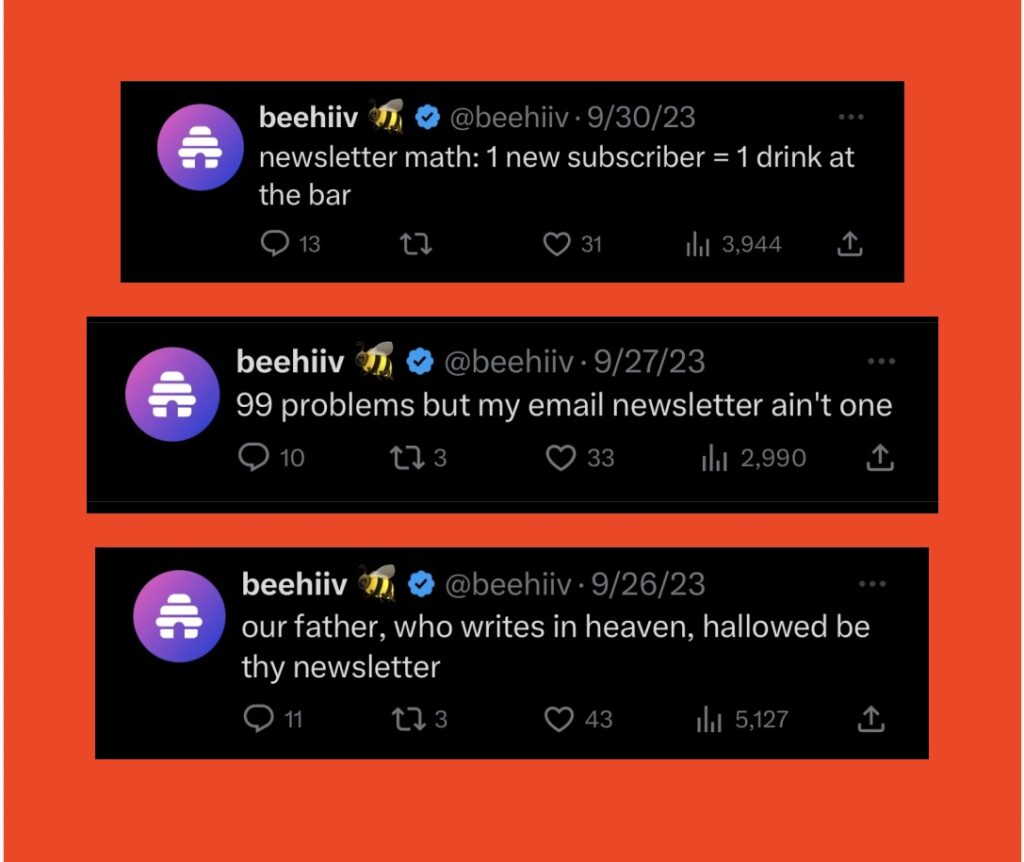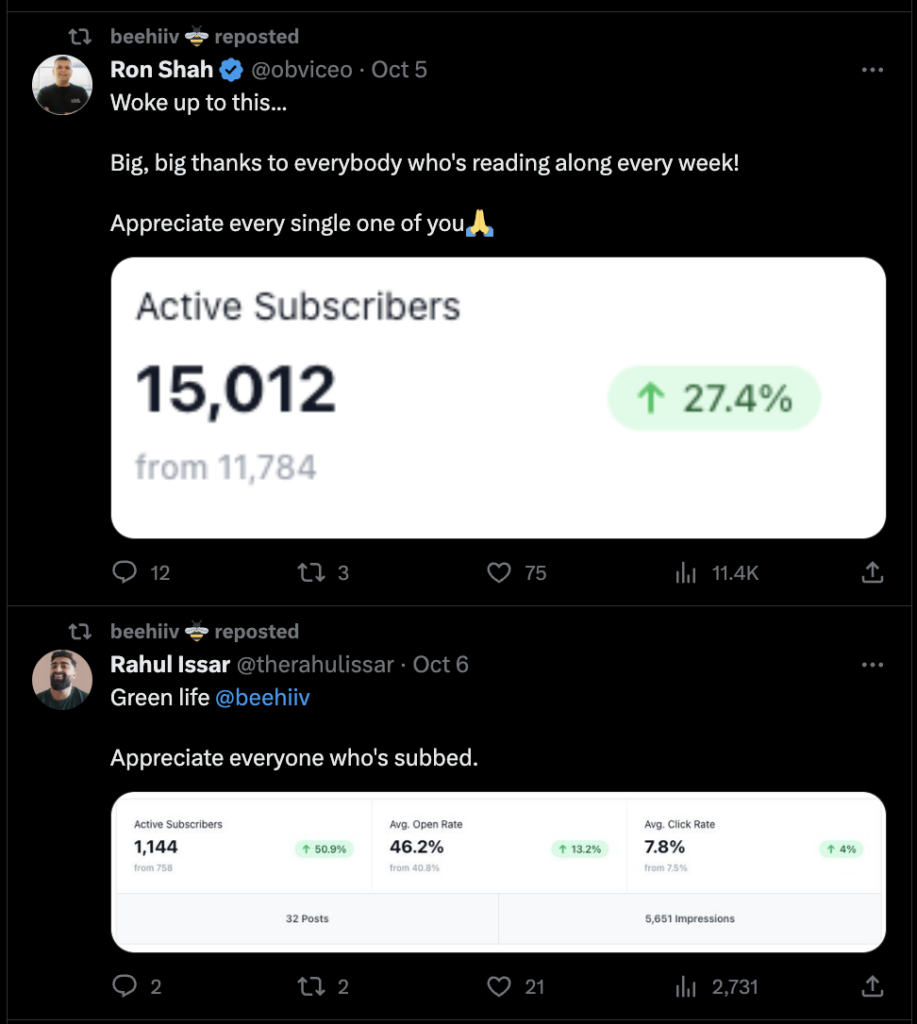09 October 2023 | Marketing
Beehiiv’s $50M Social Content Playbook
By
3 strategies that your B2B SaaS startup can apply this week
If you recall, I did a dissection of one of their tweets in a past edition of Social Files, but honestly, the strategy deserves a proper playbook breakdown.
I was thinking through how to best distill down the social strategy they’ve developed, and I landed on 3 pillars.
Let me walk you through each one.
✅ Pillar 1) Social Native Content
To any consumer brand marketers reading today’s edition, this is kind of a no-brainer. But B2B SaaS seems to be 5 years behind here.
The old SaaS social playbook: harass your community with incessant blog links and CTAs to sign up for the webinar that literally nobody but your sales team cares about.
The new SaaS social playbook: post content in the tone of voice, and the format, that your audience on social enjoys consuming (hint: it’s not the white paper full of suspect data).
Let’s tackle tone of voice first. Beehiiv keeps their TOV (tone of voice) casual on the timeline.
They chose to opt for the lower-case, ‘Gen Z’ way of typing (not a must for every brand, but it works for them).

This is night and day, from the ultra-buttoned-up (read: boring) voice most software companies use.
Again, you don’t need to adopt this exact voice. But I would encourage you to add some flare to your brand’s personality on social media.
Chi Thukral, Social Media Lead at Hubspot, gave me a great tip for developing brand voice on our most recent Social Files virtual event:
Think of your brand account as a person. What are their preferences? How do they communicate? What type of content do they like to watch? How do they text their friends?
This will help you craft a brand voice that makes sense for your company and stands out in the feed.
Now, formats.
Rather than post blog links left and right, Beehiiv leans into threads, long-form posts, etc. to communicate the same message, in a way their audience actually wants to consume.
Here’s an example:

Notice how the blog CTA is at the end of the thread, and the social user doesn’t have to click off-site to get value. The thread itself communicates all of the value located in the blog.
The reader might not click the link, but they will consume more of Beehiiv’s content on social in the coming days and weeks. I’d take that trade-off any day.
The knee-jerk response from B2B SaaS execs whenever this type of content is pitched is:
But how is this leading to sales??
Let me tell you a couple of secrets:
- Not every piece of content is meant to ‘drive leads.’
- The social-to-customer pipeline is almost never ‘see post → click link → buy”
The function of social content is to take up so much mindshare in your target customer that your product is the first to come to mind when a customer needs something in your category.
For example, the goal for Beehiiv is to be the default answer for their ICP when they’re deciding on a newsletter platform.
They do this by entertaining and educating, not by hard pitching.
✅ Pillar 2) The product is inherently shareable
I can’t go a day on Twitter without seeing at least one person share a screenshot of their Beehiiv stats, showing off their subscriber growth or email open rate.
This is social media gold.
The product taps into one of the core reasons why people share content—to make themselves look good, to brag.
Users are proud of their subscriber growth and want to let the rest of the world know.
Here’s where a lot of startups fumble the bag—and where Beehiiv nails it.
When users share their screenshots, they reward the behavior by retweeting and engaging.

Do you think people would be as likely to share if the brand account, and the Beehiiv team, just ignored the constant shoutout? Probably not.
As a company, you need to reward positive community behavior on social media. Retweet the shoutout, respond to the nice DM, etc. It doesn’t feel ‘scalable,’ but it goes such a long way.
Having your IG story or your X timeline plastered with social proof straight from your customers is a fantastic problem to have—forget your ‘aesthetic.’
Now, you either have a shareable product or you don’t. You don’t have much influence over this lever as a marketing team.
If you do, have something a growth loop like this embedded into your product, ride that wave.
✅ Pillar 3) Hyper-active team
Having team members who are active on social, whether it be X or LinkedIn, is such a cheat code for B2B startups.
People want to buy from people.
Beehiiv’s founder, Tyler Denk, is active both on the X timeline posting content and in the DMs responding to customers and prospects. The dude’s a machine.
Tyler doesn’t seem to be actively building a ‘personal brand’ either. The dude’s just ripping product updates, showing love to customers, and getting into beef with industry incumbents (G move btw).
He plays the social media game better than most founders I know. And he’s not afraid to lean into controversy to gain eyeballs.
Case in point:

1.4M views on this post about how “being single is one of the best competitive advantages as a startup founder.
- Honestly, agreed lmfao.
- 10/10 engagement bait
- This works because it’s paired with other product-related content like feature launches, social proof, customer support, etc. Gaming the algorithm doesn’t work in a vacuum. It’s top-of-funnel.
📝 Other notes
- Beehiiv executes the classic ‘own an emoji’ strategy to the tee, claiming ownership of the 🐝 emoji. I wrote more about this in this article.
- Their visual assets are well done. This is something a lot of companies skimp on. It’s clear that their product launches are at least somewhat planned ahead of time given the execution of their launches (a Herculean feat in a startup).
✅ Your cheat sheet (bookmark this)
To recap today’s social playbook:
1) Lean into social native content and develop a compelling tone of voice. Less linking out to blogs and webinars, more packaging content in a way that is meant to be consumed on-platform.
2) Having a shareable product is a force multiplier on social. If you have this luxury, don’t let it go unused. Repost social proof, reply to community comments, surprise and delight fans in the DMs.
3) Be active on social as a founder and/or marketing team. The best B2B companies on social have this to some degree. You don’t need a full-fledged personal branding strategy, though that does help. Just be active in conversations and start by connecting with customers via comments and replies. If it makes sense for your company, don’t be afraid of some banter, too 🙂
That’s all I’ve got today.